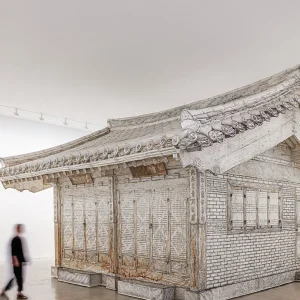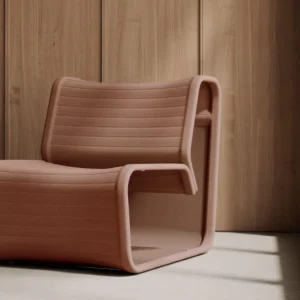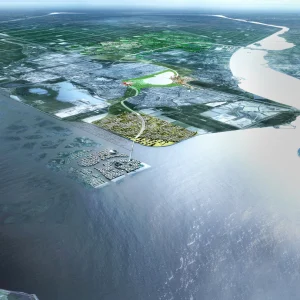
Words Norman Foster
Photography Nigel Young
The visits I made to Cuba with my wife over the past 10 years have enabled me to meet many of the community involved with the culture of art and architecture. In part this was due to the overlap between her world of art and mine of design, but we also have a shared passion for exploring contemporary works of sculpture and painting wherever our travels take us.
On our first visit we met the ‘Historiador’ of Havana, the historian Eusebio Leal Spengler. An early destination was the historic centre of the city which had been lovingly restored under the direction of Eusebio. More recently we attended the XI Bienal de Arte that introduced us to many of the local artists, whose studios we were able to visit later.

Cover of the April 1959 edition of the magazine El Automóvil de Cuba. Photo: Biblioteca De La Habana
With the celebrated Cuban ballet dancer Carlos Acosta, a principal in London’s Royal Ballet, we visited the complex of unfinished Art Schools designed by Ricardo Porro, Vittorio Garatti and Roberto Gottardi in the early Sixties. This stunning group of buildings was funded and conceived by Fidel Castro in 1961 on the former Country Club site in the suburb of Cubanacán, Havana’s equivalent of Beverly Hills. The intent was to produce ‘the most beautiful academy of arts in the whole world’. We met with the government’s architect Universo García Lorenzo to explore the feasibility of creating a ballet school for Carlos Acosta in one of the abandoned structures.

Che Guevara and Aleida March in a Studebaker on their wedding day in 1959. Photo: Nigel Young/Ivorypress
On our last visit we spent time with two artist friends, Marco Castillo and Dagoberto Rodríguez, otherwise known as Los Carpinteros. I can recall a dinner with them at the home of Marco, in a suburb of Havana. After complimenting him on his Fifties-style furnishing we were led to the garage below to stare in wonder at an impeccable Chevrolet Bel Air convertible of 1957, resplendent in turquoise with liberal dressings of chrome. Later we would debate the visual affinities of the styling of the auto designer Harley Earl with the architecture of the same year in the Hotel Riviera that is, incidentally, painted in a similar colour to the Bel Air.

A record cover for a 1955 Benny More hit. He was known in Cuba as ‘The WIldman of Rhythm’. Photo: RCA Victor
Los Carpinteros had created a major event to coincide with the Arts Festival called Conga Irreversible, which they later issued as a video. Imagine a scene in the heart of the city through which scores of dancers, all immaculately dressed in black, are parading. The traffic is halted as they move, not forwards but backwards, along the streets and squares, all swaying to the traditional music of the dance. The longer this throng travels the more bystanders are swept up and the conga becomes a strung-out line of followers, who in turn move rhythmically to the beat of the musicians.

In the Forties and Fifties, this cabaret-cum-casino Tropicana became one of the most famous in the world. Photo: Biblioteca De La Habana
While I was photographing this extraordinary happening two impressions came together as I looked through the camera’s viewfinder. First there was the backdrop of ageing buildings and cars, like a time warp of suspended decay that is unique to Cuba.
The whole country is a veritable museum of classic American automobiles, mostly from that golden age of the Fifties. In their colours and condition there is a visual rapport between the architecture and the autos, both miraculously surviving the ravages of time. In between these musings the second impression, prompted by my thoughts on the paradox of conga, was an awareness of change in the air. For example, on this visit we discovered that the local real estate market had been opened up by the government and Cubans could, for the first time since the revolution, now buy property.

In 1957 the last 200 American-made Nash cars came into Cuba. Here one is pictured in front of the famous Riviera cinema. Photo: Nigel Young/Ivorypress
As I watched this huge line of people snaking through the city, it seemed to me that soon everything in Cuba might be like anywhere else in the world. Gone would be the exotic vehicles like dinosaurs from an age long past — to be replaced by the technically superior but totally characterless cars of today. In a similar spirit, a newfound affluence might lead to wholesale redevelopment of the very particular and equally exotic mix of styles that comprises Cuban architecture. Suddenly the prospect of extinction seemed to threaten the living theatre that is Havana today — where the stage is the street, the scenery is the buildings’ facades, and the players, who bring the whole drama to life, are the colourful cars and people.

A 1958 Pontiac outside a modern dance facility designed by Ricardo Porro (1961). Photo: Nigel Young/Ivorypress
Thus was born the idea for the book — to make a record for present and future generations as well as lovers of architecture and cars to appreciate a rich cultural heritage — frozen at this critical point in time. I resolved to create it with the best talents that could be found for the task. Elena Ochoa was not only supportive of the concept as my wife, but as a publisher her Ivorypress team was central to the venture. She proposed highly creative individuals who have since contributed their knowledge and skills. We decided that the context would be set visually with images of the transition period that marked the unfolding of the revolution. Luc Chessex, a Swiss photographer, went to Cuba in 1961 and lived there for 14 years. His pictures, now half a century old, appear as fresh as ever, with a wonderful sense of immediacy. The title of his opening section ‘Cuba and the Stopped Clock’ could not be more appropriate.

The road of 10 de Octobre, one of the oldest areas in Havana. Photo: Nigel Young/Ivorypress
One of his photographs of a street scene in Havana caused me to stop and look again. For the first time I was seeing a visual connection between a woman in the foreground and the speeding automobile behind her. The two of them were given prominence by the inky background which absorbed all the detail — highlighting both of them. I had always been aware of the anthropomorphic dimension of Fifties’ American styling, but before seeing this image I had not made the sculptural connection between the full frontal of the typical auto of that period and the female form.

An example of Catalonian-inspired art nouveau architecture, designed by Mario Rotllant in 1910
If Luc Chessex sets the visual connection between the past and present, the next challenge would be to find someone who could write word pictures to summon up the history and spirit of the place. I could not think of anyone more qualified than Eusebio Leal Spengler, and there is a pleasurable link in his being the first person who introduced us to the urban delights of Havana. I greatly appreciate not only his insightful essay, but also his contribution on the ground of his home territory.

The external bodywork of a 1957 Buick with its bumpy patina of layered paint
Eusebio made valuable suggestions and offered guidance to two key members of the team — the writer and the photographer. At times all three of them worked together on location to create a seamless narrative in which images and words would be interdependent.

A two-door 1955 Mercury Monterey, which was in a garage for 45 years before the owner licked it back into shape
There was a certain inevitability about the choice of photographer. Nigel Young has for many years been an integral part of my studio in London and with his technical expertise and a discerning eye he has recorded our projects from their inception through models to completed buildings. Originally trained as an architect, his enthusiasm for the subject of this book is clearly evident in the huge volume of images that he accumulated on two visits to Cuba and which were eventually edited down to those shown here.

A 1956 Chevrolet outside Hotel Capri, where the mobster Santo Trafficante ran a casino before the revolution. Photo: Nigel Young/Ivorypress
There is a powerful idea that drives this book and it was a concept which was suggested by Mauricio Vicent, our chosen writer. He had lived many years in Cuba as a correspondent for the Spanish newspaper El País so he was very well connected. His idea was to bring forth insights through the recollections of the owners of a small number of important automobiles, mostly spanning more than one generation. Mauricio has a warmth and infectious enthusiasm that in his many interviews has drawn out memories from his subjects to bring the past alive. The tales that he records are full of colour and human frailty — they are the opposite of any dry official history.
Coming back to the start of this piece I remarked on the paradox occasioned by the spectacle of the conga. To appreciate another kind of phenomenon in the daily parade of American automotive art throughout Cuba, but particularly in Havana, it is perhaps necessary to go back to their ancestral home in Detroit.

A four-door 1957 Chevrolet opposite the Yara cinema. Photo: Nigel Young/Ivorypress
There the production lines of the three dominant manufacturers were spurred by the GI Bill of 1944 that enabled war veterans to have access to education and eventually empowered them to buy their first homes. This was followed in the next decade by President Eisenhower’s National Interstate and Defence Highways Act, which created a nationwide network of high-speed motorways. The mobility offered by these newly connected ribbons of asphalt encouraged a boom in suburban housing — a new American dream only made possible by the mass production of affordable automobiles.
Mobility was more than fast trips coast to coast, now made possible for the first time. The new generation of land cruisers even symbolised movement when they were at rest. Stylists sculpted them with tail fins derived from the most advanced jet fighters of the day. They exuded power, speed, excess and confidence, with generous dressings of chrome and multi-toned paint jobs. The automobile was more than just a mover of people — it had now become a signifier of social standing in a society that was more and more economically mobile. It was an expression of achievement.

Public transport between provinces is almost non-existent, many old cars serve as collective taxis. Photo: Nigel Young/Ivorypress
Within the league of the big three manufacturers one’s status and comparative wealth could be charted by the badge names. Moving up the ladder of aspirations the offerings of General Motor started with Chevrolet, rising through Pontiac, Oldsmobile and Buick to the pinnacle of Cadillac. The sequence of Chrysler products began with Plymouth, moved on to De Soto and Chrysler to Chrysler Imperial. The Ford Motor Company had its own hierarchy starting with Ford, going through Mercury and ending with Lincoln. For more independent spirits there were niche marques to satisfy exotic expressions of taste, even extending to European imports.
The personal ambitions that were embodied in these various name tags are reflected in the advertising and marketing brochures of the time. The image of the automobile was invariably coupled to an architectural framework of the most desirable residences or a luxury hotel, in which the driveway or forecourt was effectively an outdoor showroom to show off the family’s prized possession. Until the ascendancy of Fidel Castro all of the social nuances that were inextricably woven into the choice of an automobile were manifest in Cuba and mirrored those of mainland America, a mere 144km away. In the pages of this book the owners in their interviews tell how, almost at a stroke, all of the social distinctions were erased by the revolution and the abandoned automobiles became freely available, stripped of their rank and, like the populace who repossessed them, were suddenly deemed as equals.

This Buick has been diassembled and is being lovingly repaired by its owner. Photo: Nigel Young/Ivorypress
Imagine how the marketeers who badge-engineered successive waves of products, all conceived with terminally short lives, would feel now upon seeing the very same vehicles, some sixty or more years later, still trundling along. But all is not what it first seems on the surface. The external bodywork, aside from its bumpy patina of layered paint, may be reassuringly familiar. However the plumes of black smoke give clues to the endless recycling that has taken place within the shell by cannibalising imports from Russia and Eastern bloc countries. Often the growl of an original V8 has been replaced by the clunky knocking of a communist era diesel engine. Notwithstanding the pattern of surgical impants, the American classic car has survived remarkably intact and like a fine vintage wine they have aged well, with lines that delight the eye even more with the passage of time.
The book is a testimony to the ingenuity that keeps this vast fleet of antique autos moving, largely in the service of the community, but there is another kind of Cuban automobile that exists in a parallel world — those of aficionados who have a love affair with original examples and painstakingly restore them to pristine condition, reaching a point where they are newer than new. There are clubs of enthusiasts who come together as groups to display their treasures and compare notes with each other.
Sometimes in a street you might see one of these immaculate vehicles appearing as if it had just been delivered from the showroom. The paintwork will be perfect and without a blemish, matched by chrome polished to a mirror finish. Next to it could be parked next to an ancient wreck which is still mobile but has the appearance of a great grandfather relative to its newborn neighbour. Both are recognisably American classics but in every other way they are worlds apart.

This 1955 Mercury Monterey is a well-known fixture in the Plaza de Armas. Photo: Nigel Young/Ivorypress
In the context of Cuba they can still have something in common. Despite political rhetoric and embargoes on trade and travel between the USA and Cuba the owners of both kinds of vehicle are likely to display an affection for Americana, visible in stickers and trinkets laden with images of the Stars and Stripes. But perhaps the most reassuring aspect of the Cuban car experience is the extent to which pride of ownership crosses the political divide. In a society with the utopian quest to level everything to an equal shade of grey the brilliant colours of the automobiles and the architecture that frames them is for its sheer flamboyance unsurpassed anywhere in the world.
Notwithstanding economic strictures and abject shortages, somehow those ancient carriages not only survive but, six decades later, are still status symbols to be displayed with pride, and their finer points of detail to be the subject of discussion and debate between friends and neighbours. The architectural context of a typical street in Havana may be far removed from the leafy suburb portrayed in a Fifties marketing spread, but the social message is the same. Everything has changed but nothing has changed. Because at its essence, pride in possession and the innate desire for the individual to stand out from the crowd remains the same.





